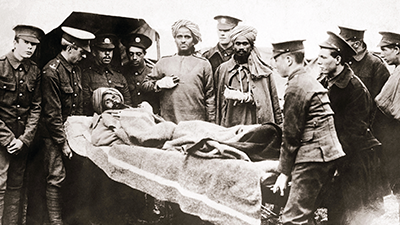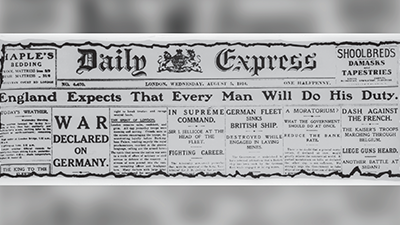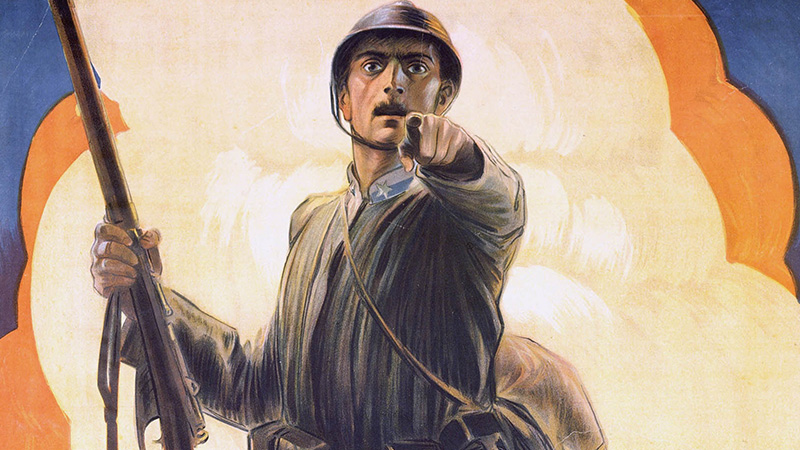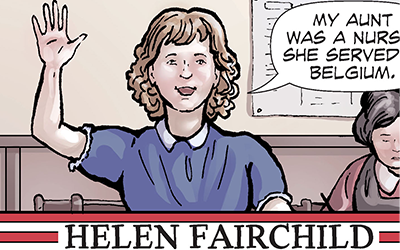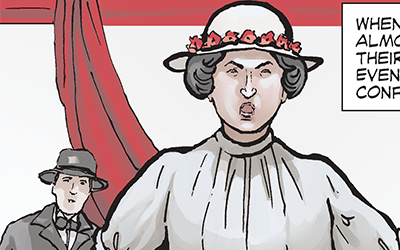Conducting World War I
Teacher Resources
Driving Question: What methods did governments use to conduct war beyond the battlefield, and how did these strategies impact societies and civilians?
Most of the fighting during World War I happened in Europe, and it was the powerful empires of Europe that dominated the conflict’s opening months and years. But this was a world war—it did not stay in Europe. The war soon drew in other nations around the world, as well as the millions of people colonized by European empires. Using new weapons of warfare and involving more people than ever before, World War I became the world’s first truly global war.
Learning Objectives
- Explain how governments used a variety of methods to conduct war.
- Assess the claim that World War I was the first global war using evidence from multiple sources.
- Analyze the various ways in which governments conducted war after 1900 by examining propaganda posters.
- Analyze primary source documents to evaluate how governments conducted war and how people responded to these methods after 1900.
Vocab Terms:
- alliance
- campaign
- disillusionment
- mobilization
- neutrality
- propaganda
- total war
Opener: Conducting World War I
To teach this lesson step, refer to page 3 of the Lesson 7.3 Teaching Guide.
Practicing historical empathy is core to understanding historical accounts. But, it can be tricky…. read about The Slippery Slope of Teaching Historical Empathy in this Forum thread.
Sometimes, the best way to understand a situation is to try to imagine yourself in it. That is just what you will do in this exercise.
The First World War as a Global War
To teach this lesson step, refer to page 5 of the Lesson 7.3 Teaching Guide.
Although World War I began in Europe, it quickly expanded into a global conflict due to the involvement of colonial powers. Many soldiers fighting in Europe came from colonized regions, and the desire for more colonies was one factor that drove the war’s spread beyond Europe.
-
Guiding Questions
-
Before you read
Preview the questions below, and then skim the article. Be sure to look at the section headings and any images.
While you read
Look for answers to these questions:
- What were the main alliances in the war?
- How did imperialism affect who fought in the war?
- What does the author argue were some global motivations for the war?
- Where were most of the battles outside of Europe fought?
- What are the main consequences of the war that this article mentions?
After you read
Respond to the following questions:
- Using evidence from this article, explain how governments used a variety of methods to conduct war.
- What elements and experiences of the First World War made it a world war? How did it become global?
World War I: A Total War?
To teach this lesson step, refer to page 7 of the Lesson 7.3 Teaching Guide.
World War I was a total war that mobilized entire societies, blurred the lines between civilians and soldiers, and demanded total national commitment. Although many citizens supported the war effort, the immense destruction also led to lasting disillusionment among both soldiers and civilians.
-
Guiding Questions
-
Before you read
Preview the questions below, and then skim the article. Be sure to look at the section headings and any images.
While you read
Look for answers to these questions:
- What does the author say are the four characteristics of total war?
- How does the author argue that World War I was different from previous wars?
- How did the war cause the spread of disease?
- The nineteenth and early twentieth century saw attempts, such as the Hague Conventions, to put restrictions on warfare. What were some ways that these rules were violated in the First World War?
- Other than wartime casualties, what were some ways that non-European societies were affected by the war?
After you read
Respond to the following questions:
- Using evidence from the text, what were the political, social, economic, and environmental effects of the war?
- The author provides the four characteristics of total war, but asserts that no war has perfectly met all these criteria. In what ways does the author seem to think World War I was a total war, even though it did not fully meet those criteria?
- The author argues that “total control of society” is an element of total war. What does she mean? Who did the controlling and who was controlled?
Britain and World War I
To teach this lesson step, refer to page 8 of the Lesson 7.3 Teaching Guide.
Britain entered World War I after Germany invaded Belgium, and the British navy, its experienced army, and its industrial strength all played key roles in the war. This video explores how trench warfare and mass casualties deeply affected British communities, with insights from military history experts.
-
Guiding Questions
-
Before you watch
Preview the questions below, and then review the transcript.
While you watch
Look for answers to these questions:
- Why did Britain have the world’s largest navy?
- Why did Britain and Germany get into a naval arms race and why did Britain win?
- What type of person served in the Guards Regiments?
- How did Belgium pull Britain into the war?
- Why is the poppy a symbol of the war?
After you watch
Respond to the following questions:
- To what extent does this video explain how governments used a variety of methods to conduct war?
- During World War I, how did Britain’s economic system provide the nation with advantages, but also create vulnerabilities?
- How does this video support, extend, or challenge what you have learned about the causes of the First World War?
Key Ideas
WWI Poster Analysis
To teach this lesson step, refer to page 9 of the Lesson 7.3 Teaching Guide.
There are a lot of posters to analyze here. Consider using the Three-Step Reading with students to “read” visuals: First, get the big picture. Then, zoom in on details. Finally, think about what the image means. Page 3 of our Reading Guide spells it out.
They say a picture paints a thousand words, and a poster can too! You will examine propaganda posters from World War I to understand the goals of governments during the war.
Source Collection: World War I
To teach this lesson step, refer to page 11 of the Lesson 7.3 Teaching Guide.
Curious about how other teachers approach sourcing? Look at this Community Forum thread on Sourcing Practice.
How did governments prepare their nations to fight “the war to end all wars”? Let’s go to the sources to find out! As you read the primary source excerpts in this collection, use the accompanying Quick-Sourcing Tool and activity to guide your analysis.
A Lost Generation
To teach this lesson step, refer to page 11 of the Lesson 7.3 Teaching Guide.
World War I caused immense suffering for both soldiers and civilians, shattering early enthusiasm for the conflict. The harsh realities of war led to widespread disillusionment and left a generation physically and mentally scarred.
-
Guiding Questions
-
Before you read
Preview the questions below, and then skim the article. Be sure to look at the section headings and any images.
While you read
Look for answers to these questions:
- Why were people enthusiastic about the war when it first began?
- How did nation-states and their rulers try to convince people, in particular young men, to join the war effort?
- What is disillusionment and why did people begin feeling disillusioned by the war?
- The author explains how these feelings of disillusionment weren’t confined to just soldiers’ thoughts about the war. Why did civilians also experience disillusionment?
- What is the double meaning of the term the “Lost Generation”?
- How was disillusionment represented in post-war art, literature, and philosophy?
- How was disillusionment experienced in European colonies in Asia and Africa?
- How did different regions of the world respond to the end of the “Great War”?
After you read
Respond to the following questions:
- Using evidence from this article, explain the causes and consequences of World War I.
- This article argues that the experience of the war changed how many people understood Enlightenment values and the idea of industrialization as progress. How would you explain these changes using the themes of cultural developments and interactions and social interactions and organization?
Closer: Conducting World War I
To teach this lesson step, refer to page 13 of the Lesson 7.3 Teaching Guide.
Claim testing is really making and testing claims. Check out this video about claim testing in the classroom.
You’ve learned a lot about World War I! Now it’s time to make some claims about the war—and prove them!
Graphic Biography: Helen Fairchild
To teach this lesson step, refer to page 14 of the Lesson 7.3 Teaching Guide.
The story of Helen Fairchild tells us a lot about service—as well as a lot about how people felt during the World War I era.
-
Guiding Questions
-
Before you read
Preview the questions below, and then skim the comic, paying attention to things like prominent colors, shapes, and types of text and fonts. How do you know where to start and in which direction to read? What’s in the gutters (the space between panels)? Who or what is the focus of the comic?
While you read
Look for answers to these questions:
- Why did Nelle Rote’s classmate tell her that her aunt’s service in WWI didn’t count?
- What did Helen Fairchild do in the war?
- How did Helen Fairchild die?
- How is Fairchild honored today in the United States?
- Look at the arrangement of the four main panels in the center of the article. Now look at the “gutters”—the space between them. What shape does it make? Why do you think the artist chose that design?
After you read
Respond to the following questions:
- Use evidence from this article to explain the causes and consequences of WWI.
- How does this biography of Helen Fairchild support, extend, or challenge what you have learned about how people thought and felt about the First World War?
Graphic Biography: Dr. Rosa Luxemburg
To teach this lesson step, refer to page 15 of the Lesson 7.3 Teaching Guide.
Not everyone supported their country’s involvement in World War I. Dr. Rosa Luxemburg had a different reaction to the war from Helen Fairchild, as you will see in this graphic biography.
-
Guiding Questions
-
Before you read
Preview the questions below, and then skim the comic, paying attention to things like prominent colors, shapes, and types of text and fonts. How do you know where to start and in which direction to read? What’s in the gutters (the space between panels)? Who or what is the focus of the comic?
While you read
Look for answers to these questions:
- Where was Dr. Rosa Luxemburg born, and what was her social position, at first?
- What did Luxemburg achieve in her life?
- How did Luxemburg feel about the war? What does the quote used in this biography tell us about her feelings?
- Look at the design of the central panel. What shape does it make? Why do you think the artist chose that design?
After you read
Respond to the following questions:
- To what extent does this article explain the causes and consequences of WWI?
- How does this biography of Rosa Luxemburg support, extend, or challenge what you have learned about how people thought and felt about the First World War?
- Compare and contrast Rosa Luxemburg’s opposition to the war to Helen Fairchild’s decision to volunteer. With whose decision are you more sympathetic? Why?


